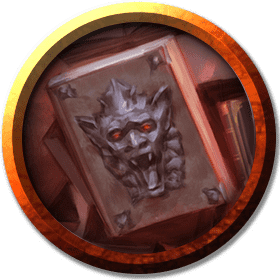Swarm of Animated Books (/swɔːm ɒv ˈænɪmeɪtɪd bʊks/)
Nothing bad happens from a book.
The Mighty Menagerie fought some in Jacoby's Eushia Home houpetor skatuch' in Eushia.
Basic Information
Biological Traits
Behaviour
Combat
Animated objects followed the will of their animator. If ordered to attack, most would slam themselves against their opponents. Different kinds of objects had other attacks available to them. For example, a rug or tapestry might wrap itself around a foe's head, effectively blinding her or him, or it might roll around a foe or group of foes and constrict. Larger animated objects could trample or crush enemies with their bulky frames.Additional Information
Uses, Products & Exploitation
Harvesting
Instructions| DC | Item | Description | Value | Weight | Expiration | Crafting |
|---|---|---|---|---|---|---|
| 10 | Animated Sigil Material | Magical dust, ash and powder, the salvaged remains of a magical rune, often used to animate certain constructs. | 5 sp | 1 lb. | ∞ | - |
This kind of creature does not normally carry treasure. This kind of creature does not normally have or collect treasure. However, the creature may have a lair full of bodies, or reside somewhere that treasure already exists.
This creature produces no Harvested Meat
Perception and Sensory Capabilities
Abilities
Animated objects always had the ability to see in the darkness and in dim light. Like other constructs, they did not need to eat, breathe, or rest; only magic kept them alive. They were immune to any effects that affected the mind and also to such things as poison and disease. What an animated object could do depended on what the object was. In general, most animated objects moved by lurching, rocking back and forth, or slithering. If the object had legs, such as a statue or table, it could walk or run. Objects with two legs tended to move more quickly than most humanoids; objects with four or more legs moved even faster than that. Objects with wheels could roll quickly, while objects that could float could also "swim". Animated ropes could climb much like a snake, and sheet-like objects could clumsily fly.Sources
Source(s):
- Mike Mearls, Jeremy Crawford, Christopher Perkins (2014-09-30). Monster Manual 5th edition. Edited by Scott Fitzgerald Gray. (Wizards of the Coast), pp. 19–20. ISBN 978-0786965614.
- Skip Williams, Jonathan Tweet, Monte Cook (July 2003). Monster Manual v.3.5. (Wizards of the Coast), pp. 13–14. ISBN 0-7869-2893-X.
- Sean K. Reynolds (2002-05-04). Deity Do's and Don'ts (Zipped PDF). Web Enhancement for Faiths and Pantheons. Wizards of the Coast. pp. 10–15. Archived from the original on 2016-11-01. Retrieved on 2018-09-08.
- Skip Williams, Jonathan Tweet, Monte Cook (July 2003). Monster Manual v.3.5. (Wizards of the Coast), p. 307. ISBN 0-7869-2893-X.
- CM, page 24
5E Statistics
 Swarm of Animated Books
Swarm of Animated Books
| Size | Medium (Swarm of Tiny Creatures) |
| Type | Construct |
| Alignment | Unalignedl |
| Challenge Rating | 1/4 |
See Also: Animated_object on Forgotten Realms Wiki



